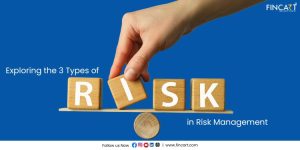Keeping money idle in a savings account erodes its value over time due to inflation. That’s why investors put their money to work. Not only does investing help them realise their financial dreams but it also keeps their money safe. In fact, one of the primary purposes of investing is to protect against inflation. Instruments like fixed deposits and government bonds are considered safe options that offer inflation beating returns. Since the returns are nearly guaranteed, they only provide moderate returns which can be suitable for capital preservation and very conservative investors.
However, the rate of returns they offer is still higher than the interest rate offered by a normal savings account. If the rate of inflation is higher than the returns offered, money loses its value. The chance that the value of your investment does not keep up with inflation is called inflation risk, and it affects different types of assets differently. Let’s understand what inflationary risk is, how it impacts investments, and what steps you can take to counteract it.
What is Inflation Risk?
Inflation risk, sometimes also called inflationary risk, is the possibility that your investment returns will not keep up with the rising inflation rate. Even if the nominal value of your investment increases, its real value, that is, the amount of goods and services it can buy will decline if inflation rises faster than your returns. Take this example to understand inflation risk – If your investment returns 5% and the rate of inflation is 6%, your real rate of return is negative 1%.
If you invested Rs. 10,000 and earned a 5% nominal return, your investment would grow to Rs. 10,500 after one year. You may think the number went up, but due to the 6% inflation rate the value of the money went down, hence your real rate of return was negative.
How Inflation Risk Affects Investments
Inflation does not impact all types of assets the same. Let’s take a look at some:
Bonds (and other fixed-income assets)
Bonds are fixed-income securities. When you purchase a bond, a portion of your investment is basically loaned to the government or a corporation in exchange for regular interest payments. After the bond matures, you get the principal back. The interest you receive is fixed, which is what makes bonds susceptible to inflation risk. This is because interest rates and inflation go hand in hand – when one rises, the other follows.
For example, suppose you buy a corporate bond. As interest rates rise, newer bonds will be issued. To stay competitive, these bonds that are newly issued offer higher interest rates compared to the bonds you hold, which makes the older bonds less attractive. Since your bond pays a fixed interest rate, it doesn’t adjust to rising inflation, which means the real value of your investment will go down.
Usually, the most attractive fixed-income securities are those which mature quickly, like short-term bonds or treasury bills. The reinvestment risk and inflation risk are reduced because investors can reinvest their principal at prevailing interest rates.
Stocks and equity mutual funds
As inflation increases, companies can increase the prices of their goods and services, and pass on the higher costs to consumers. With higher prices, companies can generate higher revenues and boost or maintain their profits. That’s why stock investments are generally seen as more favourable when inflation is high. This is especially beneficial for companies that offer inelastic goods because the demand for inelastic goods stays quite constant despite the higher prices.
These goods and services include water, salt, and petrol, that is, things that people will continue to buy even when prices rise. These companies can maintain their sales, and due to the inflation boosted prices, significantly increase their profits.
Thus, equities provide much better protection against inflation compared to fixed-income securities, but it should be noted that not all companies can maintain profitability during inflationary periods.
Real Estate
Real estate is considered a good hedge against inflation risk in investment as property rates can increase even during inflationary periods. It can even be beneficial for those earning a rental income from their properties because they can raise rents to be more in line with inflation.
Types of Inflation Risks
We can classify inflation into three types – demand-pull inflation, cost-push inflation, and built-in inflation. Each of these types affects investments differently.
1. Demand-Pull Inflation
When there is an increase in the supply of money, the demand for goods and services increases more than the production capacity of the economy. As the demand goes up, prices get higher, and the inflation rises.
2. Cost-Push Inflation
This type of inflation occurs when the prices of goods and services rise due to the increased input costs. For example, oil is an important input in many industries. When the cost of oil rises, transportation costs increase, and to maintain their profits, companies can offset these increased transportation costs by raising the price of their goods.
3. Built-In Inflation
This type of inflation stems from the idea that the current inflation rate will continue in the coming years. Consequently, workers demand higher wages to keep up with inflation, so their standard of living can say the same. As wages rise, so does the cost of goods and services. That’s why built-in inflation is also known as wage-price inflation.
The two inflationary risk types are – anticipated inflationary risk and unanticipated inflationary risk.
4. Anticipated Inflationary Risk
Based on current economic trends, investors and businesses can forecast inflation. These forecasts can help businesses prepare for anticipated inflation by adjusting their pricing models. Investors can also adjust their investment strategies and buy assets that perform well during inflationary periods.
5. Unanticipated Inflationary Risk
Inflation can also rise unexpectedly, which can catch investors off guard. Anticipated inflation risk is manageable because it allows investors to prepare beforehand and make adjustments to their strategies, however, unanticipated inflation risk can lead to significant disruptions, especially in the case of fixed-income securities like bonds.
Strategies to Mitigate Inflation Risk
Here are some ways you can manage inflation risk:
1. Investing in inflation-indexed securities
The returns of instruments like inflation-indexed bonds (IIBs) are adjusted based on inflation rates. For example, the RBI offers Inflation Indexed National Saving Securities which are designed to protect investors from inflation.
2. Investing in floating interest rate products
Such products offer interest rates that are variable and adjust regularly based on current market rates.
3. Diversification
Spreading your investments can also help mitigate the effects of inflation risk as different types of assets react differently to rising inflation. If your bonds lose value, equity mutual funds or stocks can help you make it up.
4. Real estate
Property prices appreciate over time, even during inflationary periods. Those earning a rental income from the properties can also increase rent as inflation rises.
5. Limiting exposure to long-term debt instruments
These products are particularly vulnerable to inflation risk because they lock investors into fixed interest rates for a long time. With inflation, the real returns on the investment will go down over time.
6. Investing in short-term debt
Products like T-bills and commercial papers have short maturity periods which helps in reducing exposure to interest rate fluctuations and inflation risk. As soon as your investment matures, you can reinvest at the current market rate.
Commodities like oil and gold can also be a decent hedge against inflation, but one should also consider the other risks that make them volatile before investing.
Inflation Risk in the Current Economic Climate
Your investment strategy should always take inflation rate risk into account. Over the years India has experienced varying inflation rates, and it’s important for investors to make sure their investments offer higher returns than inflation. For example, if you are investing to build your child’s higher education fund, take into account the education inflation rate, which is growing at almost double the general inflation rate.
Protect What Matters Most!
Contact Fincart for tailored insurance and risk management solutions to safeguard your future.
Conclusion
Inflation eats into the value of your money, so when you invest, it’s very important to make sure the returns outpace inflation to avoid inflation risk. Fixed-income securities like bonds are especially vulnerable to inflationary risk as the value of bonds tends to go down when inflation rises. There are many ways to reduce the impact inflation has on investments, like diversification, avoiding long-term bonds, favouring short-term instruments like t-bills and commercial papers, and investing in inflation-indexed securities and floating rate products.
Inflation risk is just one type of risk among many that affects your investments, so it’s crucial to consider other factors such as market risk, interest rate risk, credit risk, and liquidity risk. A financial advisor can help you understand how different risks affect different investments so that you can make decisions that align with your risk tolerance. A financial advisor can give you unbiased, personalised investment advice and create risk management strategies to protect your investments.




